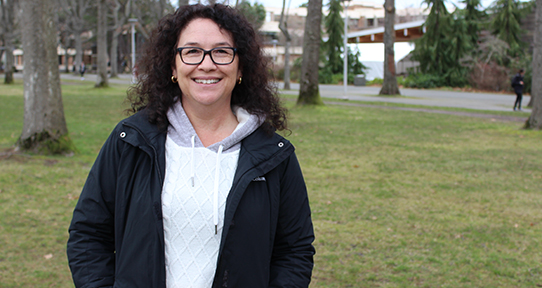Get to Know a Teacher - Spanish lecturer Alicia Ulysses

Stephanie Harrington spoke to Hispanic Studies lecturer Alicia Ulysses about her path into teaching, why she participates in University 101, and her inspired classroom style that includes dancing.
You completed a MA in Mexican Literature. What drew you to study Spanish and how did you end up teaching Spanish at UVic?
I had always wanted to be a teacher, ever since I was four years old. When I was 11, and my youngest sister was three, I used to play as though I were her teacher, and I even eventually taught her how to write. I grew up in Mexico City and my life has not been a linear plan; it has always been a gamble.
When I arrived in Victoria in 1984, I could hardly speak English, but my wonderful husband registered me in a class at UVic. It was Linguistics 099 or English for International Students. I dropped the course within three weeks since my English was definitely not at a university level. Still I continued to study English at Camosun College, which had ESL courses for immigrants.
By 1986 I wrote the TOEFL exam, and I started my studies at UVic. I loved my political science class with Dr. Terry Morley so I consulted with him about my career. At the time, I wanted to be a journalist and he told me that I could become a journalist with a degree in political science. My grades were not that great so my husband advised me to take a class in Spanish. So, in January 1987 I walked into the Spanish and Italian Department (that was the name back then), and I asked the chair for a course in Spanish. He sent me to my first Spanish literature course in fourth year and the rest is history. I graduated with a first-class degree five years later with a double major in political science and Hispanic studies.
I had my two children and I decided to stay home with them for five years, until a dear friend who I was tutoring Spanish advised me to do an MA. So I did. In 1996, I was hired by my department as a sessional instructor, and in 1998 I started a Master’s in Latin American Literature. That is how I ended up teaching Spanish, and inadvertently realized my childhood dream of being a teacher.
You teach the hugely popular beginner Spanish first-year course. What’s your approach to teaching SPAN 100?
My students are my life. When I first started teaching, my mentors were professors Rosa Stewart and Carolina Monahan. They taught me the ropes of how to teach a language course; then slowly I developed my own pedagogy over the years. I see my students as equals, as individuals that can teach me as much as they can learn from me. I never ever look down on them, just because I’m supposed to be “the expert.” I am not. Many of my students have travelled much more than me, and have diverse life experiences, and I respect and admire that. That is my teaching philosophy. When a group of students is varied in their knowledge of Spanish I still teach the class with a basic foundation, and then I individualize it from there depending on the group. Having smaller classes definitely has helped achieving this. Patience is my main skill, and storytelling.
I hear you have some unusual teaching methods that might include dancing and singing? Tell us more about this.
I want mostly for students to realize that I’m a person with a real life, and that it is okay to share those stories. They often open up with their own lives and they feel comforted by the fact that I don’t judge them. We laugh a lot. My self-deprecating sense of humour helps them relax. I never make fun of others, I make fun of my own flaws, and then they begin to relax and we end up having a good time while tackling some very difficult topics. I love music. I play to them what I call my “cheesy songs” because they are usually romantic ballads from the times when I was a teenager, and I encourage them to listen to them, and yes, then there are the dancing lessons! I love to dance, so I always make sure we have at least one dancing lesson per term. I think seeing their professor break a sweat while we dance makes them enjoy our collective humanity.
You’ve also volunteered as a teacher with University 101. What drew you to this and what do you hope to share with students about Mexican literature and culture that they may not otherwise know?
Most of the courses I have taught in the last 22 years have been language courses. However, when I finished my MA in 2005 on the literary work of Rosario Castellanos, I saw an opportunity to teach what I had studied so hard for seven years by volunteering in University 101. Castellanos is considered one of the pioneering Mexican feminist writers of the twentieth-century, as well as a recognized author who was unique in how she portrayed Indigenous peoples from Chiapas; she never subscribed to the common stereotypes in Mexico regarding Indigenous peoples and instead wrote full, complex portrayals.
I have two children. My daughter, Monique, who is a graduate of this university’s very own History department, is now in her third year of her PhD at Yale University. My other child, Nicholas, is autistic and unfortunately due to intense ableism in society, life has not always been the easiest for him. I have learned from both of my now adult children, but especially from Nicholas and the experiences he has had navigating the system in Victoria. I have seen and felt firsthand how our society discriminates against the most marginalized people, and volunteering in Uni 101 is my own way of pushing back against that.
